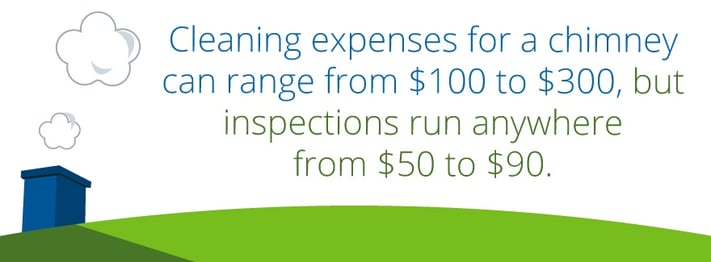
Whether you're living in a bustling, urban area or the remote hills of rural Appalachia, the cool air and stunning colors of falling autumn leaves are a good reminder that harsher weather conditions are on the way. Is your home ready for winter? While there's still time to prepare, you should already be thinking about ways prepare for the challenges of the upcoming season.
Winter's icy grip will soon take hold across much of the United States, and preparing your home in advance for several months of intense cold, snow, wind and ice can help you ensure warmth, prevent structural damage and save money on your monthly heating expenses.
As the days continue to grow shorter and the mercury steadily plummets, take a moment to review these helpful tips for winter proofing your home before curling up next to the warm glow of the fire with your favorite seasonal beverage.
Maintain Your Heating System
With the chill on its way, perhaps nothing is more important to maintaining protection against the elements than a functioning and efficient heating system. Just like preparing a vehicle for the winter months, regular maintenance is also essential in keeping your heating system running when you need it the most.
Hiring a qualified technician to inspect, repair and get your furnace running at the efficiency levels rated by the manufacturer can cost on average between $80 and $100. While the expense upfront may be a small burden, continual maintenance will keep your heating system functional longer and can help reduce monthly fuel expenses.

Another step you can take when trying to save on fuel costs and getting your home ready for winter is to replace your older thermostat with a newer, programmable model.
Make Sure It's Safe to Turn up the Heat
Before you crank that thermostat dial or light the first fire of the year, you should call a chimney sweep to inspect your chimney and ventilation system. While it might be tempting to bask in the inviting glow of that roaring fire as soon as the cold sets in, potential house fires or carbon monoxide leakage into your home can be fatal.
Even if you don't have a fireplace in your home, all types of heating systems that utilize wood, coal, gas and oil require a cleaned and properly serviced chimney for safe use. A chimney should be cleaned at least once a year and should always be serviced by a professional. If you notice a draft from your fireplace, you may need to repair or replace your damper.
Cleaning expenses for a chimney can range from $100 to $300, but inspections run anywhere from $50 to $90. When searching for a qualified chimney sweep, consider hiring one certified by the Chimney Safety Institute of America.

Since you'll be utilizing your heating resources more during the winter, it is always best to test and — if needed — purchase additional carbon monoxide and fire detectors so that every bedroom in your house is protected with its own warning system.
The majority of heating related fires occur from December through February in the United States. Annual inspections and testing are needed to keep your fire extinguishers in working order, which will provide you and your family with additional safety.
Inspect Your Roof
While a heating system is an important feature for maintaining warmth inside your home during the colder months, many external features also need maintenance in order to prep your home for winter. You should always consider the stability and effectiveness of your roof. Heavy snow, accumulating ice, snowmelt, and powerful winds can erode roofing materials, cause structural damage and end up causing leaks after winter storms.
When conducting your roof inspection, you should be on the lookout for missing or damaged shingles and hire a trained roofer to make any necessary repairs if you spot any problems. In addition, if you have gaps between vents, skylights or other areas that could cause leaks, you can seal these problem areas with caulking or roofing cement.
Clean out the Gutters
As the autumn season draws to an end, take a look at your downspouts and make sure that water is draining away from your home. All downspout drainage should run at least three to four feet away from the foundation to prevent water damage and ice accumulation.
The added weight of snow and ice buildup can also pull down gutters and cause major problems. It is important to remove any debris, foliage or blockages that can cause water to back up and cause damage to your home.
If you don't feel it's safe to remove any blockages from the gutters yourself, you can hire someone to remove the foliage and buildup for you, which could range from $70 to $225 depending on the size of the home.
Dangerous icicles and ice dams are also winter risks that can severely impact your home. If you've had problems in the past with ice, consulting an energy auditor may assist you in identifying any additional issues that can lead to ice dams and make your home safer in the future.
Hire a Professional Energy Auditor
During the winter months, your monthly energy expenses will likely rise as you pay for the resources necessary to heat your home, even if you feel you've been well-prepared.
Sometimes the heat just slips through cracks you may not have considered, both literally and figuratively. Hiring an energy auditor to assess your home might be a valuable option that could assist you in reducing your energy costs for years to come.
An auditor will assess the size of your home, each room in your house and the history of your utility bills. By using specialized equipment, auditors can detect ways that you can lower your daily energy consumption and recommend simple upgrades that can reduce your bills for a 5% - 30% savings.

Ensure Windows and Doors are Properly Insulated
After inspecting your roof for any potential areas that could leak, you should also inspect all your windows and doors to make sure your home is properly insulated.
The first step to proper insulation is to replace all of your screens with storm windows and storm doors. In addition, take a look at your weather stripping and any gaps that may be present between window and door frames.
If you see there are spaces larger than the width of a nickel, consider the benefits of adding caulking on the interior and exterior of windows and doors. Silicone caulk is relatively inexpensive and is made to withstand the elements, which can help secure your home from unwanted cold air and prevent heat from escaping.
If any of your windows are cracked or broken or the wooden frames holding them in place are deteriorating, consider getting them replaced or repaired before the snow begins to fall.
By making sure your home is adequately insulated, you will not only add long-lasting comfort on those harsh winter nights, but save yourself money by lowering the amount of fuel needed to heat your home.
Prepare Equipment and Stockpile Supplies
When the winter winds are howling and the snow is falling in sheets, you want to be prepared for snow removal. Consider what you'll need to get through the winter months and try to stock up on those supplies in advance.
Depending on the square footage and paving material used at your home, consider buying a snow blower, which will help alleviate the stress of removing snow from your driveway and walkways with a shovel.
If you already own a snow blower, you should make sure everything is in running order during your home prep for winter long before the snow blankets your driveway. Checking the snow blower's fuel levels, changing the oil and replacing its spark plugs will help guarantee you're ready for whatever Mother Nature has in store.
If you can't use a snow blower at your residence, choosing the right type of snow shovel for the job is also important. If you have heart problems, be careful when you're outside facing the wintry conditions. Shoveling is strenuous work and will raise your blood pressure. Shoveling snow for any length of time in cold weather can cause overexertion and, in some cases, has led to heart attacks.
Taking care of yourself while working outdoors by not lifting heavy loads and taking regular breaks can help reduce the strain of snow removal. Instead of hacking away at ice buildup on your walkway or driveway, use salt and ice melt to reduce the workload. In addition, sharpening your shovel blades will make cutting through layers of compacted snow and ice much easier.
Make Sure Your Bed Is Warm
When it comes to enduring the long winter nights, having enough blankets and sheets to keep you warm can make all the difference in your level of personal comfort. Once you've finished inspecting your home, making any repairs and stockpiling supplies for the icy conditions, get out those woolen blankets and extra warm comforters from storage.
As you start to rotate your wardrobe for harsher weather, you should also consider the benefits of maintaining a restful night's sleep. If you need a little more warmth now and then, having easy access to extra blankets and pillows is always welcome when you nestle in beneath the sheets on those really bitter nights.
Prepare Your Garden and Water Irrigation Systems
Other things to consider when you're preparing your home for winter include outdoor areas of your home like your lawn, garden and patio. To prevent damage to your home, you should always drain outdoor pipes and sprinkler systems. It is also beneficial to turn off the shut-off valves for outdoor faucets to prevent pipes from freezing and breaking.

If you have patio furniture adorning your deck, you can cover it with a durable, water resistant material or store it in a shed, garage or basement until the flowers begin to bloom again. Garden hoses should also be drained before you place them in storage.
Prior to putting your lawn mower away, you might want to take a few passes over any of those fallen leaves strewn across your yard and mulch them into little pieces. Using a mower is a good alternative to raking and will provide a little fertilizer for your lawn.
If you have any remaining autumn leaves on your patio or deck, you might want to consider sweeping them off to prevent them from getting wet and rotting over the next several months. When storing your mower, depleting its fuel levels or adding a fuel stabilizer will make sure it starts right away for the first grass-cutting next spring.
Trimming Trees and Shrubs
If you have large trees that precariously loom over electrical lines, it would be best to have them trimmed before winter weather leads to structural damage, injury or power outages in your neighborhood. Every year, transportation departments across the country are forced to remove tree branches from roadways following severe weather events.
In the late fall, hiring an expert to inspect your trees for stability is important for the safety of not only yourself, but motorists and neighbors as well. A trained arborist can identify the branches that would be most prone to breakage due to the added weight of snow and ice accumulation. Annual inspections for rot and dangerous branches should be conducted for all trees located near public areas.
By maintaining your trees, you will help prevent a potentially dangerous situation during a severe winter storm. Trimming tall trees or working in areas that are not easily accessible can also be very dangerous. While you may be convinced you can take care of some of those branches yourself, hiring a certified professional to cut away the problem areas is a much safer alternative.
Stay Safe and Prepared This Winter
For added safety and protection against the elements this winter, consider some of the other basic essentials that you might need to keep your family safe during the potential risks of a severe winter storm.
Stockpiling extra food, water and supplies is not a bad idea when preparing your home for winter because of the increased risk of power outages. Having extra fuel, gasoline and a backup generator can be valuable assets during prolonged outages. In addition, battery powered radios and cell phone chargers should always be kept in case of an emergency so you have access to adequate news, weather reports and communication during an outage.
By following these ten simple winter tips for your home, you should be all set for whatever harsh barrage of wintry weather events come your way. Taking those extra steps in advance will not only provide you with a safer, more comfortable home, but will also help you reduce future repair costs and lower your monthly utility expenses. Whether you're using electricity, natural gas or oil to heat your home, there are plenty of other ways to save money this year, and you can start by searching for the rates of heating oil prices in your area from Smart Touch Energy.



